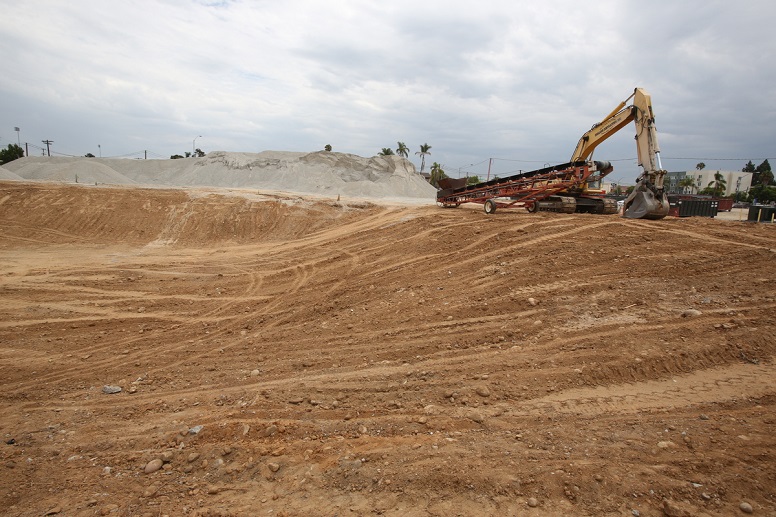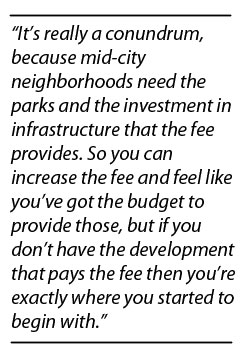
A construction crew works on the new YMCA facility in City Heights. | Photo Credit: Jamie Scott Lytle
By Megan Burks
Developers are about to pay a whole lot more in fees to build homes in San Diego’s mid-city area. The City Council approved a plan Tuesday that will increase fees there by nearly 500 percent. It will take up fees in other communities over the next two years.
It’s a risky bet that could pay off in more parks – or drive a wedge between the city and developers at the expense of the communities that need them.
A proposed increase to another fee imposed on developers, the citywide linkage fee, irked the business community so much it got the proposal thrown off the docket in March by threatening a referendum. But the mid-city fee passed with barely a peep — Building Industry Association Vice President Matt Adams made the lone opposing statement during the public comment period. He said the industry recognizes the need to raise fees but warned such a dramatic increase would stagnate development.
The decision to increase the fee came via an update of the community’s 1998 Public Facilities Financing Plan. Community plans each come with a financing plan to lay out how to pay for their long wish lists of parks, fire stations and libraries.
Fees paid by developers are supposed to cover a big chunk of those, but the outdated plans mean fee rates haven’t kept pace with inflation.
Residential developers will now have to pay $11,925 per unit, up from $2,545, if they want to build in Normal Heights, Kensington-Talmadge, City Heights and the Eastern Area. If city planners were only adjusting for inflation, the fee would be $3,701.
Councilwoman Marti Emerald represents the neighborhoods in the plan and said it was time to level the playing field with newer communities.
“There are many planned communities in San Diego, predominantly north of (Interstate) 8, that have been collecting higher fees for many, many years and because of that they do have all of these wonderful public facilities,” Emerald said. “Many of these older neighborhoods haven’t had that advantage.”
Mid-city communities have a shortage of park acreage – a shortage that, Emerald pointed out, will only be compounded by the dense development the community is slated to take on as the region’s population grows. Currently, the fees provide about 10 percent of the funding for new parks and other facilities, according to a report from the city’s independent budget analyst.
But the report also warns a sharp increase in the fees could slow development. And Dave Gatzke, who negotiates land deals for affordable housing developer Community HousingWorks, said that could defeat the purpose of the fee increase altogether.
 |
“It’s really a conundrum, because mid-city neighborhoods need the parks and the investment in infrastructure that the fee provides,” Gatzke said. “So you can increase the fee and feel like you’ve got the budget to provide those, but if you don’t have the development that pays the fee then you’re exactly where you started to begin with.”
And Gatzke said that thwarting development means thwarting affordable housing, the lack of which has caused the City Council to declare a state of emergency for years. He said the margins on affordable housing projects are already razor thin because the final product will rent for less than the market rate. And the loss of redevelopment programs statewide has eliminated the industry’s only reliable source of funding.
“It just makes the gap to produce affordable housing that much bigger,” Gatzke said.
Building industry spokesman Adams said the city needs to consider what the fee increase means for housing at all income levels.
“SANDAG says we should be averaging about 1,000 units a month just to keep pace with a growing population. We haven’t hit that mark since 2006, so as ironic as it sounds, you’re actually creating a new housing deficit,” Adams said.
He called for the increase to be phased in over time, but Emerald said residents have waited long enough. The new fee goes into effect in August.
“That’s a significant amount of money that has to be added to your project literally overnight, because one day the fee is ‘x’ and the next day the fee is ‘x times three,’” Adams said. “That’s very difficult for some projects to absorb.”
